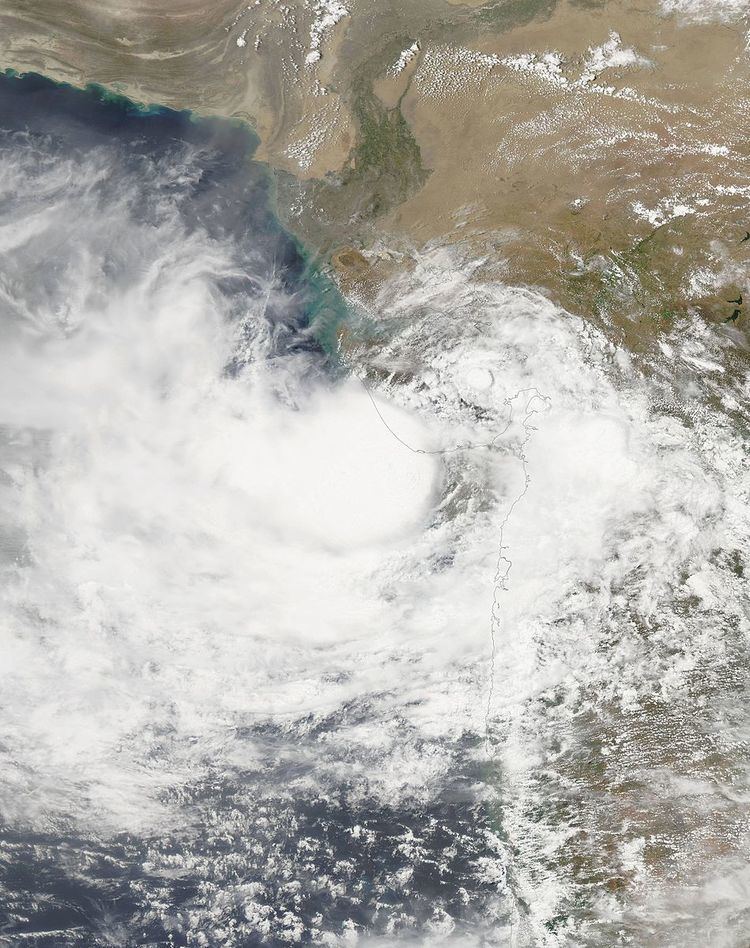Formed 22 June 2015 Fatalities At least 80 | Dissipated 24 June 2015 | |
 | ||
Highest winds 3-minute sustained: 55 km/h (35 mph) Lowest pressure 988 hPa (mbar); 29.18 inHg Damage $258 million (2015 USD)(government estimate) | ||
The 2015 Gujarat cyclone, officially Deep Depression ARB 02, brought heavy rains to the Indian state of Gujarat in June 2015. Following heavy rains, Gujarat was affected by floods. The flood is also known as the June 2015 Gujarat flood or 2015 Amreli flood. The floods resulted in at least 80 deaths. The wild life of Gir Forest National Park and the adjoining area was also affected. The monsoon in Gujarat typically starts in mid-June every year.
Contents
- Disaster Heavy flood in Shetrunji River Gujarat honarat 2015 Amreli jal pralay scary scene of flood
- Meteorological history
- Impact
- Aftermath
- References
Disaster Heavy flood in Shetrunji River Gujarat honarat 2015 Amreli jal pralay scary scene of flood
Meteorological history

Following a series of monsoonal disturbances, a fresh wave of thunderstorms organized into an area of low pressure on 21 June in the Arabian Sea, off the coast of Gujarat. Deep convection persisted to the west of the system while the circulation continued to develop over the next 24 hours, and the IMD started tracking it as a depression, with the identifier ARB 02. ARB 02 continued to develop and by the night of 22 June, the JTWC issued a TCFA on the system, while it was 285 nmi (528 km; 328 mi) west-northwest of Mumbai.
Impact
There were heavy rains on 23 and 24 June 2015 across Gujarat. Saurashtra and south Gujarat received 65.99% and 37.82% respectively of their average monsoon season rainfall in June. Central-East Gujarat received 19.92%, north Gujarat 7.45% and Kutch 7.30% of their average monsoon season rainfall. Overall Gujarat received 33.95% of its average monsoon season rainfall. These large amounts of rain falling in a short period of time resulted in flooding in Saurashtra region. Torrential rains battered Gujarat, with peak accumulations of 636 mm (25.0 in) in Bagasara, 511 mm (20.1 in) in Dhari, and 400 mm (16 in) in Variyav. Severe flooding ensued across the region, isolating many villages in the Saurashtra region.
In Saurashtra, Amreli district was badly affected, facing its worst flood in ninety years. Nearly 600 of the 838 villages in the district were flooded. More than 400 villages were inaccessible as road and rail connections were washed away due to flash floods and they had no electricity. Shetrunji river and its tributaries were flooded. A railway bridge near Gavadka collapsed and a railway line was washed away near Borala village near Savarkundla. Paschim Gujarat Vij Company Ltd (PGVCL) declared 705 electricity poles damaged. In Rajkot district, more than 1700 houses sustained damage. Jetpur town was flooded as the floodgates of Bhadar dam were opened.
There was severe damage to crops and a large number of cattle died. The flood and heavy rain resulted in more than 70 deaths across Gujarat.
The Gir Forest National Park and adjoining area housing Asiatic lions, an endangered species with only 523 living individuals documented in May 2015, was severely affected. The carcasses of 10 lions, 1670 Nilgai, 87 spotted deer, nine black bucks, six wild boars and some porcupines were also recovered.
A total of 112,217 farmers suffered major or minor damages while there has been erosion in 134,007 hectares of land.
Aftermath
The state government deployed the Indian Air Force (IAF) and National Disaster Response Force (NDRF) for rescue and relief operation. On 25 June 2015, IAF helicopters delivered more than 200,000 food packets to villages affected by the flood. Around 4,000 people were evacuated from seventeen villages downstream of Bhadar dam. More than 200 people were rescued from various places affected by the floods. The Chief Minister of Gujarat, Anandiben Patel declared Rs 400,000 as compensation to the kin of each of the deceased.
The Government of Gujarat announced a ₹ 3 billion relief package which included ₹ 1.5 billion from the National Calamity Relief Fund. The compensation for soil erosion was declared to be ₹ 25,000 per hectare for small farmers or ₹ 50,000 for farmers having more than two hectares of land. The maximum compensation was set at ₹ 60,000. For soil restoration, the government provided 5% interest subsidy for ₹ 100,000 for small farmers and ₹ 200,000 for big farmers. For crop damage, the assistance of ₹ 13,600 for minor crop and ₹ 18,000 for major crop up to one hectare land while for horticulture and banana, the assistance of ₹ 18,000 up to one hectare land was announced. For cattle deaths, compensation of ₹ 180,000 for the death of five cows or buffalo was announced. The small traders were assisted with ₹ 10,000 and shopowners with ₹ 35,000. For household damage, ₹ 7,000 were given as an assistance.
Another flood affected Gujarat a month after this storm.
